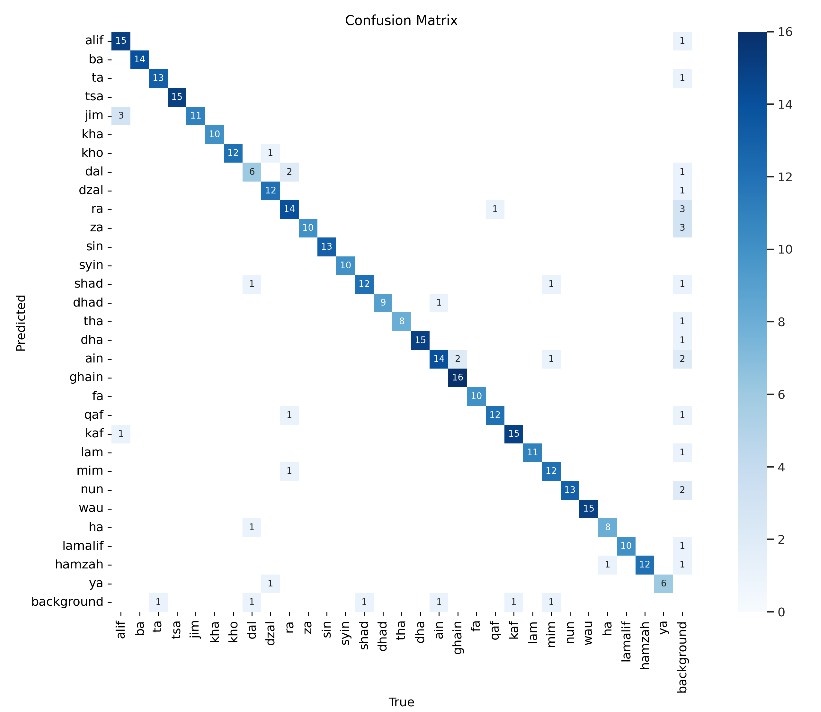Detection of Hijaiyah Letters Handwritten in Early Childhood Using Yolov8
Author's Country: Indonesia
DOI:
https://doi.org/10.36805/bitcs.v6i2.10202Keywords:
Hijaiyah letters, object detection, handwriting recognition, early childhood education, YOLO, Arabic alphabetAbstract
This study investigates the effectiveness of the YOLOv8 (You Only Look Once version 8) algorithm in detecting handwritten Hijaiyah letters among early childhood learners. The introduction of technology in early childhood education is essential for enhancing literacy skills, particularly in learning the Arabic alphabet, which is crucial for reading the Quran. This research addresses the challenges faced by educators in assessing children's handwriting, which often lacks consistency and objectivity. A dataset of 3,780 images of handwritten Hijaiyah letters was collected from children at RA BAIPAS Roudlotul Jannah, including various writing styles to ensure the model's robustness. Prior to training, the images underwent preprocessing steps such as resizing, normalization, and data augmentation techniques like rotation and flipping to enhance the quality and diversity of the training data. The YOLOv8 model was trained using an 80-10-10 split for training, validation, and testing datasets. Evaluation metrics such as precision, recall, and mean Average Precision (mAP) were used. The results showed that YOLOv8 achieved an impressive accuracy of 96.08% in detecting handwritten Hijaiyah letters, with high precision and recall rates further validating the model's reliability. This research highlights the potential of integrating advanced object detection algorithms like YOLOv8 into educational practices. By providing real-time feedback, the system can significantly enhance the learning experience for young children, facilitating their understanding and mastery of the Arabic alphabet. Future research should focus on expanding the dataset and refining the model to address handwriting variability challenges and improve accuracy.
Downloads
References
Y. Mohamed, S. Ismail, and Y. Suryadama, “Pronunciation of Hijaiyyah’s letter for New Quranic Learners a Contrastive Analysis Study,” Ulum Islam., vol. 36, no. 01, pp. 73–82, 2024, doi: 10.33102/uij.vol36no01.553.
Asmaa Rafat Elsaied, “Relationship between Numbers and Letters,” J. Math. Syst. Sci., vol. 6, no. 8, pp. 335–337, 2016, doi: 10.17265/2159-5291/2016.08.005.
L. Sarifah, S. Khotijah, and M. K. Khaliqah, “Identification Of Hijaiyah Letters Image Using Extreme Learning Machine Method,” J. Mat. Stat. dan Komputasi, vol. 20, no. 1, pp. 90–101, 2023, doi: 10.20956/j.v20i1.27158.
M. M. Bahjat, E. Sayed, M. Salem, and A. A. Ghafoor, “A Lexicon of Basic Vocabulary in the Holy Quran: The ‘Hamza’ Character as a Model,” vol. 6, no. 1, pp. 56–67, 2023, doi: 10.18860 /ijazarabi.v6i1.17642.
A. Saber, A. Taha, and K. Abd El Salam, “A Comprehensive Approach to Arabic Handwriting Recognition: Deep Convolutional Networks and Bidirectional Recurrent Models for Arabic Scripts,” Int. J. Telecommun., vol. 04, no. 02, pp. 1–11, 2024, doi: 10.21608/ijt.2024.291347.1052.
R. F. Rahmat, F. Akbar, M. F. Syahputra, M. A. Budiman, and A. Hizriadi, “An Interactive Augmented Reality Implementation of Hijaiyah Alphabet for Children Education,” J. Phys. Conf. Ser., vol. 978, no. 1, 2018, doi: 10.1088/1742-6596/978/1/012102.
K. Stein-smith et al., “The Independent Self-Directed Language Learner and the Role of the Language Educator — Expanding Access and Opportunity Kathleen,” J. Lang. Teach. Res., vol. 14, no. 2, pp. 5–13, 2023, doi: https://doi.org/10.17507/jltr.1402.01.
Siti Mahrami Ivlatia, Nina Wandana, Dita Andini Harahap, Aslam Annashir, and Sahkholid Nasution, “Analisis Kompetensi Penulisan Huruf Hijāiyah Tunggal Pada Siswa MIS UMMI Lubuk Pakam,” Semant. J. Ris. Ilmu Pendidikan, Bhs. dan Budaya, vol. 2, no. 1, pp. 188–200, Jan. 2024, doi: 10.61132/semantik.v2i1.284.
H. Sidi, A. Yuniar, and F. Marisa, “Expression Detection of Children with Special Needs Using Yolov4-Tiny,” vol. 16, no. 3, pp. 221–227, 2025.
A. Y. Rahman and Z. Zakaria, “Hybrid YOLOv8 and Fast R-CNN for Accurate Schematic Detection in Power Distribution Networks,” IEEE Access, vol. PP, p. 1, 2025, doi: 10.1109/ACCESS.2025.3561279.
J. J. P. Jansen, C. Heavey, T. J. M. Mom, Z. Simsek, and S. A. Zahra, “Scaling-up: Building, Leading and Sustaining Rapid Growth Over Time,” J. Manag. Stud., vol. 60, no. 3, pp. 581–604, May 2023, doi: 10.1111/joms.12910.
V. C. Raykar and A. Saha, “Data split strategies for evolving predictive models,” Lect. Notes Comput. Sci. (including Subser. Lect. Notes Artif. Intell. Lect. Notes Bioinformatics), vol. 9284, pp. 3–19, 2015, doi: 10.1007/978-3-319-23528-8_1.
Z. Q. Zhao, P. Zheng, S. T. Xu, and X. Wu, “Object Detection with Deep Learning: A Review,” IEEE Trans. Neural Networks Learn. Syst., vol. 30, no. 11, pp. 3212–3232, 2019, doi: 10.1109/TNNLS.2018.2876865.
R. Padilla, W. L. Passos, T. L. B. Dias, S. L. Netto, and E. A. B. Da Silva, “A comparative analysis of object detection metrics with a companion open-source toolkit,” Electron., vol. 10, no. 3, pp. 1–28, Feb. 2021, doi: 10.3390/electronics10030279.
Priyatna, B., Rahman, T. K. A., Hananto, A. L., Hananto, A., & Rahman, A. Y. (2024). MobileNet Backbone Based Approach for Quality Classification of Straw Mushrooms (Volvariella volvacea) Using Convolutional Neural Networks (CNN). JOIV: International Journal on Informatics Visualization, 8(3-2), 1749-1754.

Downloads
Published
Issue
Section
License

This work is licensed under a Lisensi Creative Commons Atribusi-BerbagiSerupa 4.0 Internasional.



